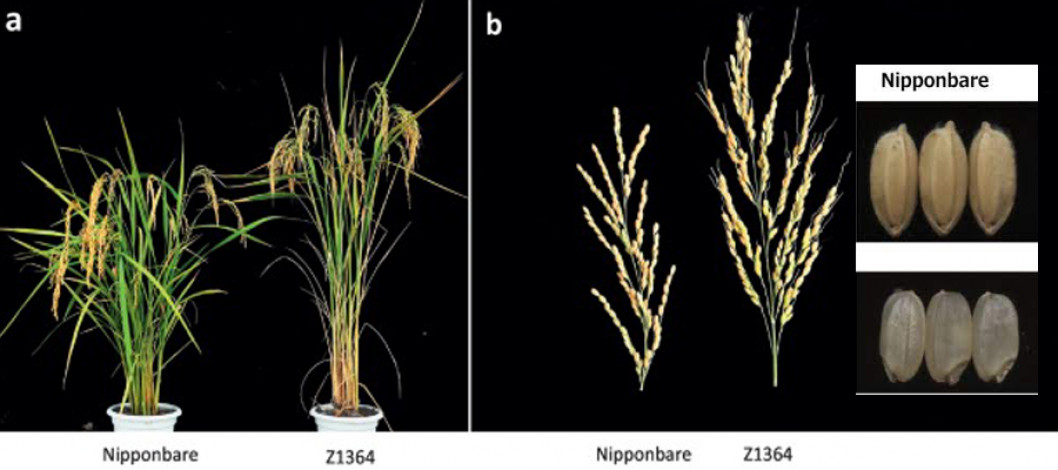
File Photo
Researchers claim to have boosted yields by 40 percent by inserting a second copy of its own gene into a Chinese rice variety called Nipponbare. This research team from the Chinese Academy of Agricultural Sciences (CAAS) obtained this result by inserting an extra copy of a known gene called QSDREBIC into a rice variety called Nipponbare.
This genetic
modification enables the rice plant to absorb more fertilizer and multiplies
the photosynthetic rate and accelerates flowering. All these features
contribute to the yield of major cereal crops, scientists said Such surprising
news has been published in the world-famous science journal Science on July 23,
2022. They removed this homologue from other rice plants and obtained comparative
evidence of its effectiveness in transgenic plants
Greenhouse experiments by CAS scientists Shaobo Wei and Jia
Li showed that plants without the gene grew less than control plants, while
plants with extra copies of QSDREBIC grew faster and had longer roots. A plant
geneticist at Rothamsted Research Institute Mr. In Matthew Paul's words,
"I don't think we've seen success like this before." This method can
be tried in other crops too.
Over the years, biotechnologists have searched for single
genes in crops that are uniquely suited to increase yield. In recent years they
have shifted their interest to genes that regulate other genes, and in
physiological terms that is multidirectional; For example, it controls nutrient
absorption from the soil, increases the rate of photosynthesis and transport of
food from leaves to seeds. Changing such a regulatory gene in corn can increase
yields by more than 10 percent, which can only be increased by 1 percent per
year with conventional plant breeding methods. As a result, they consider it a
big achievement compared to conventional plant breeding methods.
A team led by Kass plant biologist Wenbin Zhou identified
118 rice and maize regulatory genes, including proteins called transcription
factors, which other researchers had previously identified as potentially
important genes influencing photosynthesis Mr. Zhou's team tried to find out if
any genes are activated in rice grown in low-nitrogen soils, because such genes
can increase the plant's uptake of nutrients from the soil. The team found 13
genes that were upregulated when rice seedlings were grown in low-nitrogen-rich
soil; And five of these genes are capable of increasing nitrogen uptake
fourfold or more One reason for the better nutrient uptake rates is that plants
with extra copies of QSDREBIC take up more nitrogen through their roots and
transfer more of it to the shoots.
Improved rice developed in this way has produced high yields
in temperate to tropical climate zones in three locations in China in the past
two to three years. Specifically, the researchers also transformed a
high-yielding rice variety planted by farmers by adding an extra copy of the
gene. These modified modern rice plants yielded 40 percent more per plot than
the control rice, the researchers said.
Mr. Pam Ronald, a rice geneticist at the University of
California, Davis, said the 40 percent yield increase was a big achievement and
a surprise. Steve Long, a plant physiologist at the University of Illinois,
Urbana-Champaign, said, "These transformed plants produced higher yields
in the field as well as in the greenhouse test, which is very promising."
Plants transformed in this way flower sooner, which gives
them more time to produce seeds on their spread Depending on the environment,
this can be an effective variety for early flowering For example, this variety
may allow farmers to grow more crops each season or harvest before the summer
heat or other advantages. However, the modified Nipponbare flowered 19 days
earlier, while other widely cultivated cultivars flowered only two days
earlier. To demonstrate greater potential, the research team found a similar
effect by combining the rice QSDREBIC gene with a wheat research variety.
QSDREBIC and similar genes are present not only in rice, wheat and other grass
crops, but also in many broadleaf plants. Researchers found better results by
adding an extra copy of such a gene to a type of mustard plant called
Arabidopsis. This is very consistent with a general process across the plant
kingdom, suggesting that other similar crops may be amenable to yield increases
from this change.
The transgenic rice varieties developed by Mr. Zhou and his
team may be unacceptable to some consumers. But Mr. Zhou and his colleagues say
they see no problem if this yield increase is accomplished by editing the
plant's own genes, unless it is transferred from another plant or source. It is
now seen as easier than transgenic engineering in some countries. Another
advantage is that by increasing the rate and efficiency of nitrogen uptake by
crops, it can also reduce the pollution of rivers and lakes caused by runoff
after excess fertilizer application to paddy fields. Therefore, Oxford
University scientist Mr. Steven Kelly said, 'This innovation will add new
dimensions to global food production due to improved photosynthetic
efficiency.'
|Source: Online/TA
Comment Now